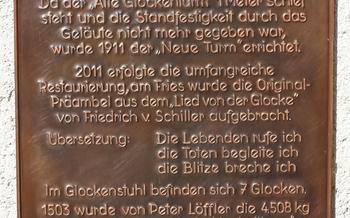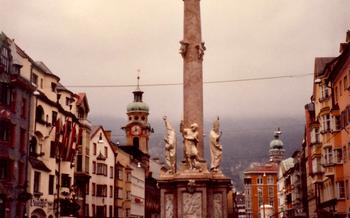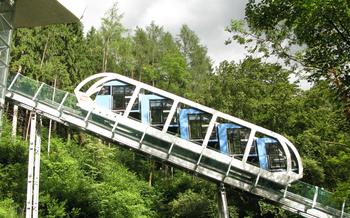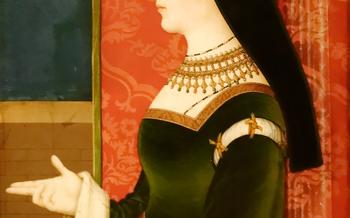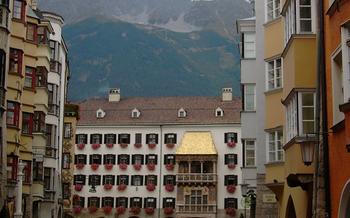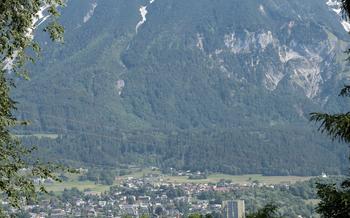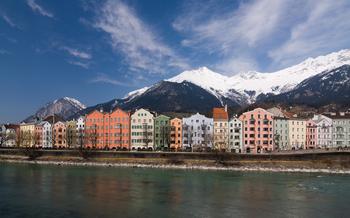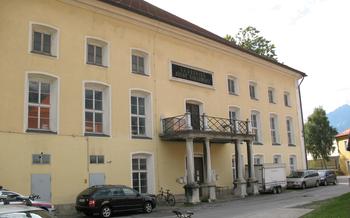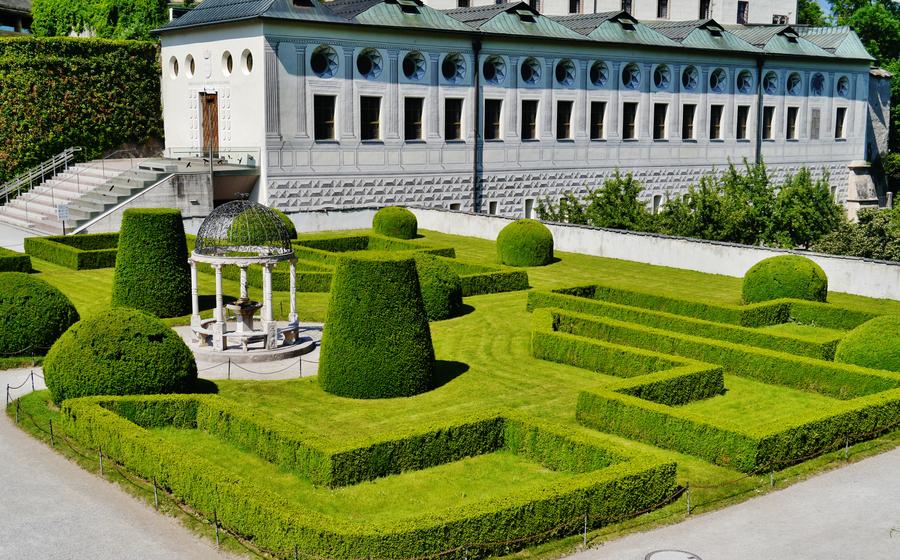
Schloss Ambras Innsbruck
- The Spanish Hall
- The Ambras Collection
- The Hall of Curiosities:
- The Armory
- The Renaissance Garden
- The Chapel of St. Nicholas:
- The Giant's Chamber: A Realm of Mystery and Fascination
- The Imperial Hunting Lodge
- The Ambras Congress
- The Ambras Castle Park:
- Guided Tours and Audio Guides
- Accessibility and Facilities:
- Insider Tip:
The Spanish Hall
The Spanish Hall is the centerpiece of Schloss Ambras, a stunning architectural masterpiece that encapsulates the grandeur of the Renaissance period. Step into this magnificent hall and be captivated by its intricate ceiling frescoes, which depict scenes from mythology and history. The walls are adorned with life-size portraits of the Habsburg family, each exuding an aura of power and prestige.
The hall's construction was commissioned by Archduke Ferdinand II, who envisioned a space that would serve as a testament to his reign and the Habsburg dynasty's illustrious history. The result is a harmonious blend of art, history, and grandeur.
Today, the Spanish Hall serves as a venue for special events, exhibitions, and concerts. Its acoustics are renowned for their clarity, making it an ideal setting for musical performances. As you stand beneath the vaulted ceiling, surrounded by centuries-old artwork, you can't help but feel a sense of awe and wonder. This hall is a testament to the artistic and cultural legacy of the Habsburgs, and it continues to inspire and captivate visitors to this day.
Unique Features and Artwork:
- The ceiling frescoes were painted by the Italian artist, Hans Rottenhammer, and depict scenes from mythology and history.
- The walls are adorned with life-size portraits of the Habsburg family, each painted by a different artist.
- The hall's acoustics are renowned for their clarity, making it an ideal setting for musical performances.
Contribution of Archduke Ferdinand II:
- Archduke Ferdinand II commissioned the construction of the Spanish Hall as a testament to his reign and the Habsburg dynasty's illustrious history.
- He personally oversaw the design and construction of the hall, ensuring that it reflected his vision of a grand and opulent space.
Current Exhibitions and Displays:
- The Spanish Hall is used for special events, exhibitions, and concerts.
- It houses a collection of historical artifacts, including armor, weapons, and tapestries.
- The hall is also used for temporary exhibitions showcasing various aspects of Tyrolean history and culture.
The Ambras Collection
The Ambras Collection is a diverse and eclectic assemblage of artifacts, artworks, and curiosities amassed by Archduke Ferdinand II of Tyrol in the 16th century. It is widely regarded as one of the most significant collections of its kind from the Renaissance period.
Among the highlights of the collection are exquisite paintings, sculptures, and tapestries, reflecting the cultural and artistic influences of the era. Particularly noteworthy are the portraits of Philippine Welser, Ferdinand II's beloved wife, and the famous Ambras Heldenbuch, a lavishly illustrated manuscript depicting scenes from medieval German literature.
The Ambras Collection holds profound historical importance for Tyrol. It offers a glimpse into the passions, interests, and worldview of Ferdinand II, a prominent figure in Tyrolean history. The collection also serves as a testament to the cultural and intellectual exchange that flourished in the region during the Renaissance.
The Hall of Curiosities:
The Hall of Curiosities, known as the "Kunst- und Wunderkammer," is a captivating realm within Ambras Castle, showcasing a diverse and eclectic collection of artifacts that ignite wonder and intrigue. This remarkable chamber, established by Archduke Ferdinand II in the 16th century, epitomizes his insatiable curiosity and passion for collecting rare and unusual objects.
Ferdinand II, a renowned patron of the arts and sciences, meticulously assembled a vast array of curiosities that defied conventional categorization. The hall became a microcosm of his multifaceted interests, ranging from natural history specimens to exotic artifacts from distant lands. It served as a cabinet of wonders, where visitors could marvel at the marvels of the natural world and the ingenuity of human creation.
Among the highlights of the collection are exotic seashells, intricate ivory carvings, and taxidermied animals, each possessing a unique story. One particularly captivating exhibit is the "Unicorn's Horn," a narwhal tusk believed to hold magical properties. Visitors can also marvel at a fossilized fish from the Miocene epoch, offering a glimpse into prehistoric life.
The Hall of Curiosities transcends mere display; it invites visitors to embark on a journey of discovery and wonder. It epitomizes Ferdinand II's insatiable quest for knowledge and his dedication to preserving the extraordinary. Stories and legends surround the exhibits, adding a touch of mystery and enchantment to this extraordinary chamber.
The Armory
The armory at Schloss Ambras is a treasure trove of military history, showcasing an impressive collection of weapons and armor from different eras and cultures. This remarkable arsenal provides a fascinating glimpse into the martial prowess and defensive capabilities of Tyrol throughout the ages.
The collection encompasses an array of weaponry, from gleaming swords and intricate daggers to imposing suits of armor that once protected valiant knights on the battlefield. Visitors can marvel at the intricate craftsmanship and attention to detail exhibited in each piece, as well as the sheer variety of armaments on display.
The armory also holds significant historical value, as it houses weapons that played a pivotal role in Tyrolean history. These include swords wielded by renowned Tyrolean rulers and armor worn by soldiers who fought in epic battles that shaped the region's destiny. Each artifact tells a story of bravery, resilience, and the enduring spirit of the Tyrolean people.
For history enthusiasts and those intrigued by the art of warfare, the armory at Schloss Ambras is a must-see attraction. It offers a unique opportunity to explore the rich military heritage of Tyrol and gain insights into the strategies and technologies that shaped the course of history.
The Renaissance Garden
Positioned in the south of Schloss Ambras, the Renaissance Garden represents an excellent example of Renaissance garden design. Its creation, which is attributed to Archduke Ferdinand II, occurred during the 16th century and was inspired by Italian gardens.
This beautiful garden features an intricate layout characterized by symmetrical flower beds, geometrically trimmed hedges, and pathways arranged in a grid pattern. Visitors can admire the vibrant colors and fragrances of a variety of flowers, including roses, carnations, and lilies. The garden also boasts an aviary, where visitors can observe a diverse collection of birds.
In the past, the Renaissance Garden served as a place of leisure and recreation for the Habsburg family and their guests. Today, it remains a popular spot for locals and tourists alike to stroll, relax, and appreciate the beauty of nature. During the summer months, concerts and other cultural events are often held in the garden, creating an enchanting ambiance.
Insider Tip: For a unique experience, visit the Renaissance Garden during the early morning hours when the air is still cool and the gardens are less crowded. You'll have the chance to soak in the tranquility and capture stunning photographs without the hustle and bustle of the daytime crowds.
The Chapel of St. Nicholas:
The Chapel of St. Nicholas stands as a testament to the profound spiritual significance embedded within the walls of Schloss Ambras Innsbruck. Constructed around 1570 under the auspices of Archduke Ferdinand II, this sacred space exudes an atmosphere of serenity and reverence. Its architectural design mirrors the prevailing Renaissance style, characterized by elegant simplicity and harmonious proportions.
Within the chapel, visitors are captivated by intricate artwork and religious artifacts that adorn its interior. The altarpiece, a masterpiece crafted by Giovanni Battista Fontana, depicts the serene countenance of the Madonna and Child, flanked by a celestial entourage. The walls are adorned with frescoes showcasing scenes from the life of Jesus Christ, inviting visitors on a visual pilgrimage through His earthly journey.
The chapel also houses an impressive collection of religious relics, including a fragment of the True Cross, believed to possess miraculous healing powers. These relics were diligently collected by Ferdinand II, who was deeply devoted to his faith and sought to create a sacred space that would inspire and uplift the hearts of all who entered.
Practical Information:
- Visitors can explore the Chapel of St. Nicholas as part of a guided tour of Schloss Ambras Innsbruck.
- Photography is permitted within the chapel, but visitors are kindly requested to maintain a respectful silence and refrain from using flash photography.
- The chapel is accessible to visitors of all abilities, with ramps and elevators providing easy access for those with mobility challenges.
The Giant's Chamber: A Realm of Mystery and Fascination
Deep within the heart of Schloss Ambras Innsbruck lies a chamber shrouded in mystery and intrigue: the Giant's Chamber. This unique and captivating space is a testament to the rich history and legends that permeate the castle's walls.
As you step into the Giant's Chamber, you are greeted by a sight that is both awe-inspiring and unsettling. The room is dominated by a massive stone table, flanked by two colossal chairs that seem to dwarf any ordinary visitor. The table is adorned with intricate carvings and symbols, hinting at the enigmatic stories it could tell.
The chamber's origins are steeped in mystery, with legends dating back to the Middle Ages. One tale speaks of a gentle giant who once resided in the castle, using the massive table for his meals and gatherings. Another legend suggests that the chamber was a meeting place for a secret society, where members would engage in mystical rituals and discussions.
Whatever its true history, the Giant's Chamber has become a symbol of the castle's captivating allure. Visitors are drawn to its enigmatic atmosphere, eager to unravel the secrets that linger within its walls. Today, the chamber is occasionally used for special events and exhibitions, adding to its mystique and charm.
As you stand in the Giant's Chamber, surrounded by an aura of mystery and wonder, you can't help but feel a sense of connection to the past. The room invites you to let your imagination soar, to envision the giants who may have once graced its presence, and to ponder the secrets that it continues to hold.
The Imperial Hunting Lodge
Nestled amidst the picturesque landscapes of Innsbruck, the Imperial Hunting Lodge stands as a testament to the grandeur of Tyrolean history. Built in the 16th century under the patronage of Archduke Ferdinand II, this magnificent lodge served as a retreat for the Habsburg royalty during their hunting expeditions in the surrounding forests.
With its elegant Renaissance architecture, the hunting lodge boasts intricate stone carvings, ornate gables, and a striking clock tower that dominates the skyline. The interiors are adorned with opulent furnishings, tapestries, and artwork, reflecting the refined tastes of the Habsburgs.
Today, the Imperial Hunting Lodge is open to the public, offering visitors a glimpse into the lavish lifestyle of the Tyrolean nobility. Guided tours provide insights into the history of the lodge and its significance in the context of Tyrolean culture. Visitors can also explore the surrounding grounds, which feature well-maintained gardens, tranquil ponds, and panoramic views of the Alpine scenery.
For those interested in history, architecture, and the grandeur of the Habsburg era, the Imperial Hunting Lodge is a must-visit destination. It is easily accessible from Innsbruck city center, making it a convenient addition to any itinerary.
The Ambras Congress
In 1564, Schloss Ambras played host to a momentous event that would leave an indelible mark on Tyrolean history: the Ambras Congress. Convened by Archduke Ferdinand II, this gathering of European dignitaries and scholars served as a platform for diplomatic negotiations and cultural exchange. The congress aimed to address various political and religious issues that had plagued the region for decades, particularly the ongoing conflicts between Protestants and Catholics.
Ferdinand II, a skilled diplomat and patron of the arts, recognized the potential of Schloss Ambras as a neutral ground for dialogue and reconciliation. He invited representatives from different countries and religious backgrounds, including the Holy Roman Emperor Maximilian II, the Elector of Saxony, and the Duke of Bavaria. Over several weeks, the delegates engaged in intense discussions, seeking common ground and exploring avenues for peaceful coexistence.
The Ambras Congress, although ultimately unable to resolve all conflicts, laid the foundation for future diplomatic efforts and contributed to a greater understanding among the various parties involved. It showcased Ferdinand II's commitment to fostering peace and harmony in the region, solidifying his reputation as a wise and benevolent ruler.
The Ambras Castle Park:
The Ambras Castle Park is a sprawling, picturesque landscape that surrounds the iconic Ambras Castle in Innsbruck, Austria. With its verdant meadows, tranquil ponds, and towering trees, the park offers visitors a serene escape from the bustling city and a chance to immerse themselves in nature's beauty.
The park's history dates back to the 16th century when Archduke Ferdinand II, a passionate horticulturist, transformed the area into a magnificent Renaissance garden. Ferdinand's vision was to create a harmonious blend of nature and art, and he meticulously planned the layout of the park, incorporating geometric patterns, water features, and sculptures.
Today, the Ambras Castle Park remains a testament to Ferdinand's love of nature and his keen eye for design. Visitors can stroll along the park's winding paths, admiring the colorful flowerbeds, manicured hedges, and towering trees that create a sense of tranquility and awe.
The park is not just a visual feast but also a haven for wildlife. The ponds are home to a variety of waterfowl, including ducks, geese, and swans, while the trees provide shelter and nesting sites for numerous bird species. Visitors can often spot squirrels scampering through the undergrowth or catch a glimpse of rabbits hopping across the meadows.
In addition to its natural beauty, the Ambras Castle Park also offers a range of recreational activities for visitors of all ages. There are several walking and jogging trails that wind through the park, providing opportunities for exercise and fresh air. Children can enjoy playing in the playground, while adults can relax on the park benches and soak up the tranquil atmosphere.
The Ambras Castle Park is a perfect place to escape the hustle and bustle of city life and reconnect with nature. Whether you're looking for a leisurely stroll, a fun family outing, or a chance to admire the beauty of the Renaissance, the park has something to offer everyone.
Guided Tours and Audio Guides
Guided Tours: Schloss Ambras offers guided tours in various languages, including English, German, and Italian. These tours provide an in-depth exploration of the castle's history, architecture, and collections. Knowledgeable guides lead visitors through the castle's grand halls, sharing fascinating stories and insights about the Habsburg dynasty and the artifacts on display.
Audio Guides: For those who prefer a self-guided experience, audio guides are available in multiple languages. These guides offer a comprehensive commentary on the castle's highlights, allowing visitors to explore at their own pace. The audio guides provide detailed information about the exhibits, the history of the castle, and the lives of its former inhabitants.
Booking and Costs: Guided tours and audio guides can be booked in advance online or on-site at the castle's ticket office. Prices for guided tours vary depending on the group size and language, while audio guides are available for a fixed fee. It's recommended to book guided tours in advance, especially during peak tourist season, to secure a spot.
Insider Tip: For a truly immersive experience, consider booking a guided tour led by a costumed guide. Dressed in historical attire, these guides bring the castle's past to life, offering a unique and memorable way to explore Schloss Ambras.
Accessibility and Facilities:
Schloss Ambras Innsbruck is committed to providing an inclusive and accessible experience for all visitors. The castle offers a range of accessibility features to ensure that everyone can enjoy its wonders.
Wheelchair users and visitors with limited mobility can explore the castle's main attractions, including the Spanish Hall, the Ambras Collection, and the Renaissance Garden, via accessible routes and ramps. Designated accessible restrooms are also available throughout the castle grounds.
For those who require additional assistance, guided tours with sign language interpretation can be arranged upon request. Audio guides are also available in several languages, providing a detailed and informative experience for visitors of all abilities.
The castle offers ample parking spaces, including designated disabled parking bays. Visitors arriving by public transportation can easily reach the castle from the Innsbruck city center via bus or tram.
To ensure a smooth and enjoyable visit, visitors with specific accessibility needs are encouraged to contact the castle's Visitor Services team in advance. The team is dedicated to providing personalized assistance and making necessary arrangements to accommodate individual requirements.
Insider Tip:
For an unforgettable experience, plan your visit to Schloss Ambras Innsbruck during the summer months, when the weather is at its most pleasant and the castle grounds are in full bloom. Take advantage of the opportunity to stroll through the picturesque Renaissance Garden, basking in the warmth of the sun as you admire the meticulously manicured lawns and vibrant floral displays.
If you're a history buff, time your visit to coincide with one of the many special events or exhibitions held throughout the year. These events offer a unique opportunity to delve deeper into the rich history of the castle and its inhabitants. From medieval jousting tournaments to Renaissance music concerts, there's something for every taste.
For those seeking hidden gems, venture beyond the main attractions to discover the lesser-known corners of the castle. Explore the Giant's Chamber, an intriguing room adorned with fantastical frescoes and sculptures, or seek out the charming Philippine Welser's Chamber, where you can learn about the fascinating life of this remarkable woman.
As you wander through the halls of Schloss Ambras Innsbruck, let your imagination transport you back in time. Picture Archduke Ferdinand II, surrounded by his court, hosting lavish banquets and engaging in intellectual discussions. Imagine the footsteps of Philippine Welser echoing through the corridors as she moved gracefully among her guests.
Whether you're a history enthusiast, an art lover, or simply someone who appreciates the beauty of well-preserved architecture, Schloss Ambras Innsbruck is a place where you can lose yourself in the past and create memories that will last a lifetime.
